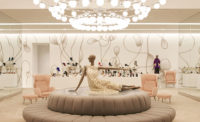Mexico City
Everything inside Downtown—a buzzing hotel, hostel, restaurant, and retail complex in the center of Mexico City —has a story. The mescals you sip on the mezzanine come from small producers, their biographies explained by a bartender presiding over rows of minimalist glass bottles. Around the corner, a boutique sells modern dresses made with traditional weaving techniques by artisans who share 50 percent of the shop's profits. The building itself, constructed during the late 17th century, was once home to the Countess of Miravalle, for whom the city's Condesa neighborhood is named. An imposing manse with heavy masonry walls, it was used as a hotel in the 19th century and returned to a private residence in the early 20th. Most recently, it served as a jewelry market, with its walls plastered over and a courtyard converted into a garage.
For the building's latest chapter, a young local firm, CheremSerrano, has renovated it into a platform for all things cool in Mexico City, a self-conscious embodiment of the capital's reputation for food, art, design, and culture. “It was important to create a scene,” says principal Abraham Cherem, who has slowly begun renaming his firm Cherem Arquitectos following the tragic murder of cofounder Javier Serrano at age 29 just a few months before the project opened. The scene they set has a cosmopolitan affect and a fetish for authenticity discernible in its bohemian mix of architectural elements. The designers preserved remnants from each era of the 38,000-square-foot, four-level building's history, peeling back finishes, salvaging materials, and making careful alterations to the landmarked structure. “We wanted to make it particular,” says Cherem, “to be contemporary but with a Mexican flavor in the materials.”
The building sits two blocks from the Zócalo, the city's main square. Following a wave of investment in the area, the project's developers acquired the property and brought in Grupo Habita—the indomitably hip hoteliers behind the Americano in New York and Endémico on the Baja peninsula—to turn it into a flagship destination in the formerly downmarket district. The hotel group devised the Downtown brand, playing off the building's history, a renewed interest in the neighborhood, and a taste for haute Mexican craft, and selected Cherem and Serrano to help refine and execute the idea, working it into the fabric of the structure.
The architects kept large storefront retail spaces for tenants able to pay a premium to occupy the street-side exposure. Beyond a massive front door, they placed restaurants (helmed by well-known chefs and designed by separate firms) in two of the building's courtyards. Up a curving 19th-century stair that dominates the main patio, the mezzanine level holds smaller retail spaces with less expensive rents to accommodate independent shops. On the building's upper floors, the architects identified space for 16 luxury hotel suites, and, following a recent trend, they placed 17 hostel rooms around a third courtyard to take advantage of a warren of small existing spaces. “We couldn-t market $200-plus-per-night stays in rooms that used to be the mansion's servants' quarters, but we couldn't demolish any of the original walls either,” says Rafael Micha, one of Grupo Habita's managing partners, “so a well-designed hostel made sense.”
The architects made significant but deft interventions in the structure. They uncovered the masonry walls and reinforced them to meet contemporary seismic standards. They added a steel deck to the roof to support a pool and bar. They also inserted a new stair without modifying the floor plan by dropping it through an air shaft cut into the building decades ago to house HVAC equipment.
To create continuity among the varied spaces, the firm devised a simple brick lattice motif that reappears throughout the complex. In the hotel suites, it forms partitions between living, sleeping, and bath areas with a natural finish that echoes the historic materials. In the hostel, the firm used it for bunk beds—the project's most fun move—painting the bricks a Barragán-inspired acid yellow. “They're like sculptures in the middle of the room,” says Cherem of the feature, which gave the hostel, Downtown Beds, its name.
Layered and atmospheric, the building invites exploration, and each space—from a restored 19th-century elevator to the thoughtfully curated shops—fits a rough but chic aesthetic that reads as distinctly Mexico City, but with a playfulness that keeps it from feeling overly precious. “International travelers want to be a part of a story—a story about a Mexican designer, a brewer, a chocolatier, or a countess,” says Micha. “It's about going back home and saying, 'I just discovered this amazing thing.' ”
Size: 38,000 square feet
Cost: $1.5 million
Completion date: July 2012
PeopleOwner: Sacal Family
Architect:
Personnel in architect's firm who should receive special credit:
Interior designer:
Engineer(s):
Consultant(s):
Lighting: Luis Lozoya General contractor: 'Vigilante de la Construcci'n'
Photographer(s):
Renderer(s):
CAD system, project management, or other software used: |
Products
Windows
Glazing
Doors Wood doors: 'Vigilante de la Construcci'n', Alfonso Reyes
Interior finishes Paints and stains: Manuel Rodriguez Lozano (Mural)
Solid surfacing: Special surfacing: Some of the tiles used for the project were recovered from the original site. Floor and wall tile: Some tiles were recovered from site and used on the kitchen walls, the restaurant floor and in some bedrooms.
Furnishings
Fixed seating: Paul Roco CheremSerrano
Chairs: Paul Roco
Upholstery: Paul Roco Other furniture: Paulistano Chair
Lighting Downlights: Non used Task lighting: Custom made incandescent fixture, with T10 60w clear lamp on a manual dimmer Exterior: facade: Metal Halide wallwasher Interior: Halogen uplights, LED uplights for the trees, and LED striplight on steps, and coves. Dimming System or other lighting controls: LEVITON, Dimention modules for public areas, Decora wallbox manual dimmers in the rooms.
Conveyance
Plumbing |











Post a comment to this article
Report Abusive Comment